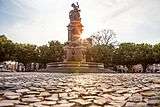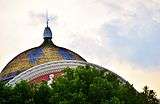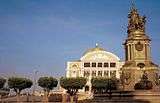Amazon Theatre
| Amazon Theatre | |
|---|---|
| Teatro Amazonas | |
|
Amazon Theatre | |
| General information | |
| Type | Opera house |
| Architectural style | Renaissance |
| Address |
Eduardo Ribeiro Avenue Centro |
| Town or city | Manaus |
| Country | Brazil |
| Coordinates | 3°7′49″S 60°1′24″W / 3.13028°S 60.02333°W |
| Elevation | 92 m (302 ft) |
| Current tenants | Amazonas Philharmonic |
| Construction started | 1884 |
| Inaugurated | December 31, 1896 |
| Owner | Amazonas State president |
| Dimensions | |
| Other dimensions | 68,70m x 124,50m[1] |
| Technical details | |
| Floor count | 3 |
| Floor area | 92 meters |
| Design and construction | |
| Architect | Celestial Sacardim[1] |
| Architecture firm | Portuguese Office of engineering and architecture[1] |
| Structural engineer | Bernardo Antônio de Oliveira Braga[1] |
| Other designers | Crispim do Amaral |
| Other information | |
| Seating capacity | 701 |
The Amazon Theatre (Portuguese: Teatro Amazonas) is an opera house located in Manaus, in the heart of the Amazon rainforest in Brazil. It is the location of the annual Festival Amazonas de Ópera (Amazonas Opera Festival) and the home of the Amazonas Philharmonic Orchestra which regularly rehearses and performs at the Amazon Theater along with choirs, musical concerts and other performances.
History
The Amazonas Theatre was built during the Belle Époque at a time when fortunes were made in the rubber boom. Construction of the Amazon Theatre was first proposed in 1881 by a member of the local House of Representatives, Antonio Jose Fernandes Júnior, who envisioned a "jewel" in the heart of the Amazon rainforest.[2]
In 1882, the State legislature approved some limited financing, but this was considered insufficient. Later that year, the president of the Province, José Lustosa Paranaguá, approved a larger budget and initiated a competition for the presentation of plans. The chosen project was made by the Gabinete Português de Engenharia e Arquitectura, an engineering and architecture office from Lisbon. By 1884, construction was ready to begin under the Italian architect Celestial Sacardim. Work proceeded slowly over the following fifteen years with some stops and restarts from 1885 to 1892.
By 1895, when the masonry work and exterior were completed, the decoration of the interior and the installation of electric lighting could begin more rapidly. The theatre was inaugurated on December 31, 1896, with the first performance occurring on January 7, 1897, with the Italian opera, La Gioconda, by Amilcare Ponchielli.
Architecture and style
The theatre's architectural style is considered typically Renaissance. The roofing tiles were imported from Alsace, the steel walls from Glasgow, Scotland and the Carrara marble for the stairs, statues and columns, from Italy. The dome is covered with 36,000 decorated ceramic tiles painted in the colors of the national flag of Brazil. The interior furnishing came from France in the Louis Quinze style. Italian artist Domenico de Angelis the Younger painted the panels that decorate the ceilings of the auditorium and of the audience chamber. The curtain, with its painting "Meeting of the Waters", was originally created in Paris by Crispim do Amaral. The theatre's 198 chandeliers were imported from Italy, including 32 of Murano glass.
Internal Structure
- Show room: Has ability to 701 people, its distribution of posts is given in the following way, ground floor with 266 seats, cabins with 100 seats distributed, 1st floor with 110 seats distributed in cabins, 2nd floor with 125 seats distributed in 25 cabins, 3rd floor with 100 seats distributed in 20 cabins.
- Principal Stage of Presentation: Owns 10.50 metres wide, 6.40 meters high and 11.97 meters deep, the principal stage has 14 meters high, the total area is 123.29 square meters.
- Part of the Orchestra: Height: 2 m; Width: 6 ' 11; Length: 7 m.




In popular culture

- The theatre is featured in the film Fitzcarraldo[3] directed by the German director Werner Herzog in 1982. At the beginning of the film, the opera-obsessed character Brian Sweeney "Fitzcarraldo" Fitzgerald makes his way by paddling his own boat to the opera house to hear Enrico Caruso sing in Verdi's Ernani,[4] which also features aging Sarah Bernhardt whose role is sung by an off-stage soprano. (Sarah seems to think she is in Lucia di Lammermoor, with its mad scene). Fitzcarraldo arrives right at the end of the opera, and there are scenes of the interior of the opera house. While it is believed that the opera house was constructed to attract Caruso to perform at its opening, there is some doubt that he actually did perform there.
- It is featured twice in novels by Eva Ibbotson: Journey to the River Sea[5][6] and A Company of Swans. Both are adventure stories set principally in the city of Manaus (where the theatre is situated) and surroundings in 1912. In the former (children's) book a visiting acting group performs the play, Little Lord Fauntleroy at the theatre, which is briefly described. In the latter (young adult) novel a visiting ballet troupe performs Swan Lake, Giselle, The Nutcracker and La Fille Mal Gardee at the theatre.
- The theatre was featured in Ann Patchett's 2011 novel, "State of Wonder".
References
- 1 2 3 4 Souza, João Mendonça de. O Grande Amazonas (The Great Amazon).
- ↑ The Guardian UK, Tuesday 14 April 2015 11.29 BST
- ↑ Herzog, Werner (2001). Herzog on Herzog. Faber and Faber. ISBN 0-571-20708-1.
- ↑ Art of Darkness, The Progressive, August 1982
- ↑ "And the winner is ... : ... a book that lasts. Kevin Crossley-Holland's The Seeing Stone creates a real world whose people you will remember a lifetime, says Anne Fine, introducing our recommendations for young readers". [Anne Fine]. The Guardian 9 October 2001. Retrieved 2012-06-19.
- ↑ "Press Desk: Shortlists for the CILIP Carnegie and Kate Greenaway Children's Book Awarded in 2002". The CILIP Carnegie and Kate Greenaway Children's Book Awards. n.d. Retrieved 2009-06-15.
Further reading
- Author and naturalist Sy Montgomery gives a historical account of the building of the theater in her 2001 book, "Journey of the Pink Dolphins".
External links
| Wikimedia Commons has media related to Amazon Theatre. |
- Teatro Amazonas Official website of the Amazonas Department of Culture. (Portuguese).
- Amazon Theatre Gallery of 19 photos of the Amazon Theatre by Jorge Vismara
- Amazon Theatre Gallery of 26 photos of the Amazon Theatre by Vagamundos
Coordinates: 3°07′49″S 60°01′24″W / 3.13028°S 60.02333°W
